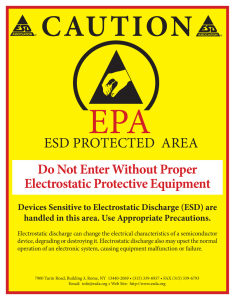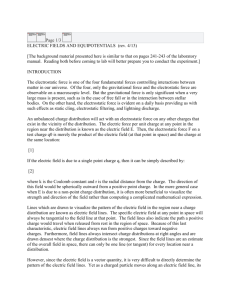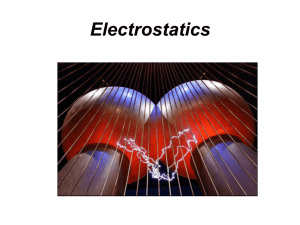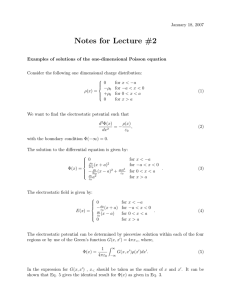ESD Protection Procedures - vossloh
advertisement
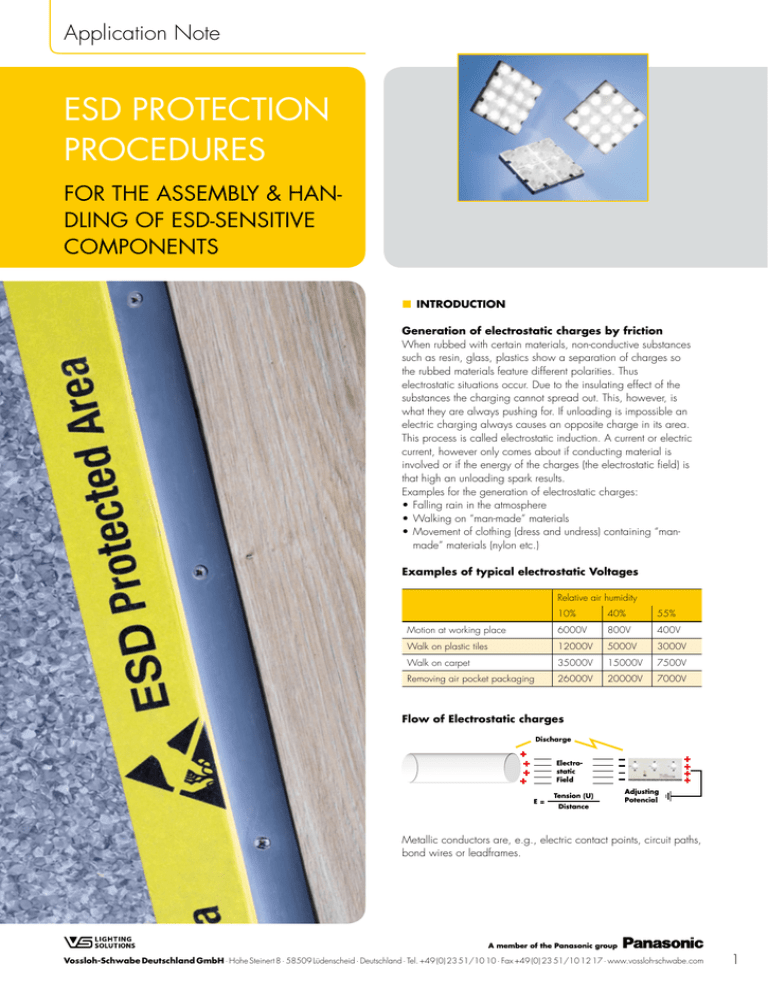
Application Note ESD PROTECTION PROCEDURES FOR THE ASSEMBLY & HANDLING OF ESD-SENSITIVE COMPONENTS INTRODUCTION Generation of electrostatic charges by friction When rubbed with certain materials, non-conductive substances such as resin, glass, plastics show a separation of charges so the rubbed materials feature different polarities. Thus electrostatic situations occur. Due to the insulating effect of the substances the charging cannot spread out. This, however, is what they are always pushing for. If unloading is impossible an electric charging always causes an opposite charge in its area. This process is called electrostatic induction. A current or electric current, however only comes about if conducting material is involved or if the energy of the charges (the electrostatic field) is that high an unloading spark results. Examples for the generation of electrostatic charges: •Falling rain in the atmosphere •Walking on “man-made” materials •Movement of clothing (dress and undress) containing “manmade” materials (nylon etc.) Examples of typical electrostatic Voltages Relative air humidity 10% 40% 55% Motion at working place 6000V 800V 400V Walk on plastic tiles 12000V 5000V 3000V Walk on carpet 35000V 15000V 7500V Removing air pocket packaging 26000V 20000V 7000V Flow of Electrostatic charges Metallic conductors are, e.g., electric contact points, circuit paths, bond wires or leadframes. Vossloh-Schwabe Deutschland GmbH · Hohe Steinert 8 · 58509 Lüdenscheid · Deutschland · Tel. +49 (0) 23 51/10 10 · Fax +49 (0) 23 51/10 12 17 · www.vossloh-schwabe.com 1 ESD Protection Procedures Electrostatic discharges Case 1: Due to a large electrostatic field discharging occurs with a spark formation. Case 2: The charges are abruptly compensated by free charge carriers Important Only small electrostatic voltages can destroy LED-chips and ICs. GENERAL RECOMMENDATIONS For work in electronic protective zones •Access to electronic protective zones is only is permitted in authorised clothing, i.e. a suitable protective white coat, shoes that can discharge and/or a wrist band. •It is essential to point out the protective measures to any visitors. •Visitors are only allowed access to protective zones if they are suitably dressed in the above indicated outfits. •It is also essential to avoid “hard” discharges, for example, on metal foil or metal plate. •The following applies to electrostatic sensitive components: –– Only allow parts to contact material that can discharge in order to assure that eventual charges may “smoothly” flow off (controlled potential balancing). –– Never work on components near to charged or chargeable items. –– Only use appropriate tools, devices and materials. –– Slit existing adhesive tapes, don’t tear them. –– Use gloves or finger stalls that can discharge. –– The components may only leave the ESD-protective area in packing and transport boxes conforming to standards. For single work places (ESD-islands), for technical customer service and for installation on site The following also applies: •Wear working clothes that can discharge. •Always wear an earthed wrist band. For technical customer service the working mat and service suitcase must be connected with each other and earthed (permanent potential adjustment). In the event that the appliance to be repaired has a conductive housing, the mat, suitcase and wrist belt must be connected to it. •Never remove the components in question from packaging outside the “ESD-island”. •If trolleys are required for transport, only trolleys that can discharge should be used. The trolleys should be integrated into the potential adjustment. In stand-by positions on ground that does not discharge, the trolleys must be earthed. For examining and repairing ESD-sensitive components •Test probes must show zero potential when contacting. Their environment must be free of any potential electrostatic charge (e.g. acrylic glass screens). •Test holders must show zero potential when plugging or unplugging ESD-sensitive components. •Test equipment must not generate voltage peaks when being switched on or off. •All unused inputs should be connected either to the supply voltage or to the reference potential. All relevant information in technical literature has to be observed. •At entries signal voltages must only be set before or after switching on the supply voltage. Signal voltages must be switched off before or at the moment of switching off the supply voltage. •Soldering guns and final soldering devices must be equipped with grounded tips. No voltage peaks must be generated by controllers or power supply voltage. •Coolant spray must only be used if the device to be examined is in an in-circuit emulator with adjusting potential. Vossloh-Schwabe Deutschland GmbH · Hohe Steinert 8 · 58509 Lüdenscheid · Germany · Phone +49 (0) 23 51/10 10 · Fax +49 (0) 23 51/10 12 17 · www.vossloh-schwabe.com 2 ESD Protection Procedures WARNING NOTICES IN AN ELECTRONIC PROTECTIVE ZONE EPA (ESD-PROTECTED-AREA) STANDARDS DIN EN 61340-5-1 Electrostatics – Protection of electronic components against electrostatic phenomenon General requirements DIN EN 61340-5-2 Electrostatics – Protection of electronic components against electrostatic phenomenon User manual DIN IEC 61340-4-1 Electrostatics – Part 4-1: Standard test methods for specific applications – Electrical resistance of floor coverings and installed floors ANSI/ESD S.20.20-1999 ESD Association standard for the development of an electrostatic discharge control program Vossloh-Schwabe Deutschland GmbH · Hohe Steinert 8 · 58509 Lüdenscheid · Germany · Phone +49 (0) 23 51/10 10 · Fax +49 (0) 23 51/10 12 17 · www.vossloh-schwabe.com 3
